A curious fact about Brazilian folk-pottery is that, although familiar to the Portuguese for centuries, the potter’s wheel is not used. This is supposed to be because the present-day potters in Brazil learned their art from the Indians rather than from Portuguese tradition. Even without the wheel, the Indians for a thousand years or so have made — and are making — bowls and urns, sometimes of enormous size: huge pots for fermenting liquor, or funerary urns big enough to hold the body of an adult, sitting in foetal position. These pots are built up by the “rope” method, long thin ropes of clay superimposed, round and round, until the required height and shape are reached, then the ridges smoothed down. The backlands potters (women, as with the Indians) make pots of great elegance in this primitive way, decorate them with black, white, and earth colors, and polish them with the rinds of fruit.
Besides dishes & jugs for practical purposes made by women, men sometimes make clay figures, an art derived from Africa. Sometimes colored and glazed, sometimes clay-color, these little statues or whole groups of them depict all the types and activities of their society: the “cowboys,” soldiers, priests, hunters, a wedding, a funeral, a jaguar-hunt, a team of oxen, etc. Women potters occasionally make figures, and at Ipu, in Ceará, they are known for their miniature pots and pans, dishes and furniture and animals — toys for children, sometimes surprisingly like the toys the Greek and Roman potters made for children and that survive in the museums. From Bahia State come sitting-hens, turkeys, snakes, whole trees full of birds — brightly colored and gay. Pots for the baby copy exactly in clay the usual enamel model, those glazed inside costing a few pennies more than the unglazed ones.
Another art has developed in the zones the sociologists call the “leather-culture” (pastoral): a great variety of articles made from calf-skin. The most esteemed, however, are those of deer-skin — and deer are plentiful in the scrub-forests of the northeast. The cowboy’s leather costume is made to protect him from the thorns and sharp-edged leaves of the caatinga, the scrub-forest, and its varieties of low-growing cacti and thorny trees. It is like medieval armor, made in leather: leggings, serving the same purpose as an American cowboy’s “chaps,” but tight-fitting and extending over the top of the foot, like spats; an apron, a “chest-protector,” and over all the leather “doublet,” with long sleeves meeting the leather gloves or mitts. On his head the cowboy wears a leather hat, with a strap under the chin. All these garments are fancifully decorated: embroidered, inlaid in different colored leather, stamped. Their saddles are equally objects of art, and their long, quilted capes, and decorated whips with fine lashes (made from bulls’ pizzles).
Besides the art of pottery, the women of the north and northeast have inherited the art of working in straw from their Indian grandmothers: mats, bags, baskets, hats. In one part of Ceará they make straw hats similar to the “Panamas” of Panama and Chile in their softness and fineness. Baskets, fish-traps, coarse and fine sieves, mats woven to be used as ceilings below the naked rafters. In Pará State, influenced by Portuguese workers in wicker, there is a home industry of furniture-making in reeds, rushes, wickers, etc. Travellers on the Amazon are startled to be begged to buy large wicker rocking-chairs, perched across the sterns of tiny canoes.
The most famous straw-work, however, are the hammocks woven of cord or thread made from several varieties of palm. They are soft and supple, straw-colored, as fine as silk. They are not used for sleeping in, but hung for siestas on the shady porches. For sleeping, hammocks of woven cotton are used, but coarser ones in bright plaids (the Portuguese, like the Scotch, are devoted to plaids), unsystematic plaids or all-white — the more valuable kind. The foot-wide borders of these hammocks (called “varandas”) are an art in themselves — special patterns, in “knotted lace” with long fringes. In the big ranch houses of the sertãos the “hammock chests” are an indication of the owner’s wealth, big chests of cedar or other fragrant woods where dozens of the valuable snow-white hammocks are packed away with sprigs of marjoram between them.
One casa grande in the State of Ceará had 120 hammocks in its chests, for 120 guests. This was on the fazenda called “California,” built in 1850 and hopefully named “California” for the California gold rush. This fazenda was founded in 1850, without a name. A friend of the owner inquired, “How’s so-&-so with his California?” (referring to the American gold rush of ’49) and so it was named “California.” Besides the hammocks for 120 guests who might want to spend the night, there were special “priests’ hammocks,” for their periodical visits. The lace “varandas” of these showed crosses, crossed lances (emblems of the Passion), and bunches of grapes and ears of wheat (emblems of the Eucharist).
Another art inherited from the Indian is the cúia, or decorated gourd, enamelled black, used as dippers and for bathing. The enamel is a secret, handed down from generation to generation. The decorations are often very beautiful, incised in the gourd and left in natural color, or brightly painted: flowers, fruits, flags, and such sentiments as: Souvenir, Independence or Death! Mother Love, or Happy Birthday.
From the Portuguese and also the Moors, the Brazilian women have inherited the art of lace-making, exquisitely fine lace that taxes the eyes and the patience: a hand’s-breadth is often more than a day’s work. Lace made from thread of banana-leaf fibres instead of commercial thread is particularly rare and valuable. The weavers of Mato Grosso also use this delicate fibre, an art learned from the Paraguayan Indians. Drawn-work, crocheted and knitted lace, embroideries — where the patterns have not been coarsened or “modernized”—are also very beautiful. The most famous lace-makers are from the town of Aracati in Ceará State, but the laces of the State of Santa Catarina, made by descendants of immigrants from the Azores are also famous. There is a whole group of folk-songs devoted to the lace-makers; some of them have to do with the saga of the notorious northeast bandit Lampião (killed in 1938). Strange to say, the war-song of Lampião’s bandits was “The Lace Maker”: “Oh, lace-maker! / Oh woman making lace! / Teach me how to make lace / And I’ll teach you how to love…”
In the gold-mining regions, Minas Gerais, Goiás, Bahia, the goldsmith’s art developed, with much skilled workmanship, often showing Moorish influence in its filigrees and arabesques. The stones set in these pieces are usually rough diamonds, or the many Brazilian semi-precious stones: aquamarines, topazes, amethysts, and tourmalines. A great deal of work is done in Bahia with gold and silver, ivory and coral, often in the form of amulets, lucky charms. The figa, or “fig,” in English, is seen everywhere in Brazil: tiny ones hung around babies’ necks, along with the medal of a saint, and big ones, of wood, hung on the walls. This immemorial image of a clenched fist with the thumb protruding between the first two fingers is seen everywhere in Brazil. (Shakespeare speaks of it, but it antedates Shakespeare by many centuries.) Also from Bahia are the balangandãs, jingling bunches of charms formerly worn by slave women, at their waists, and now collectors’ items. The charms are several inches long: pomegranites, cashew-fruits, musical instruments, phallic symbols, objects of macumba rites. From Goiás come rosaries of gold beads, with the “Our Fathers” of coral or baroque pearls.
Читать дальше












